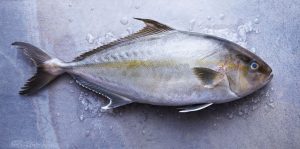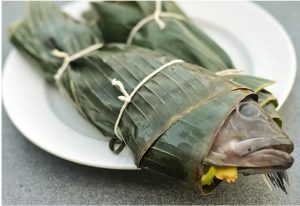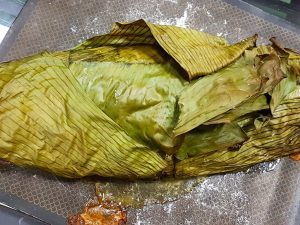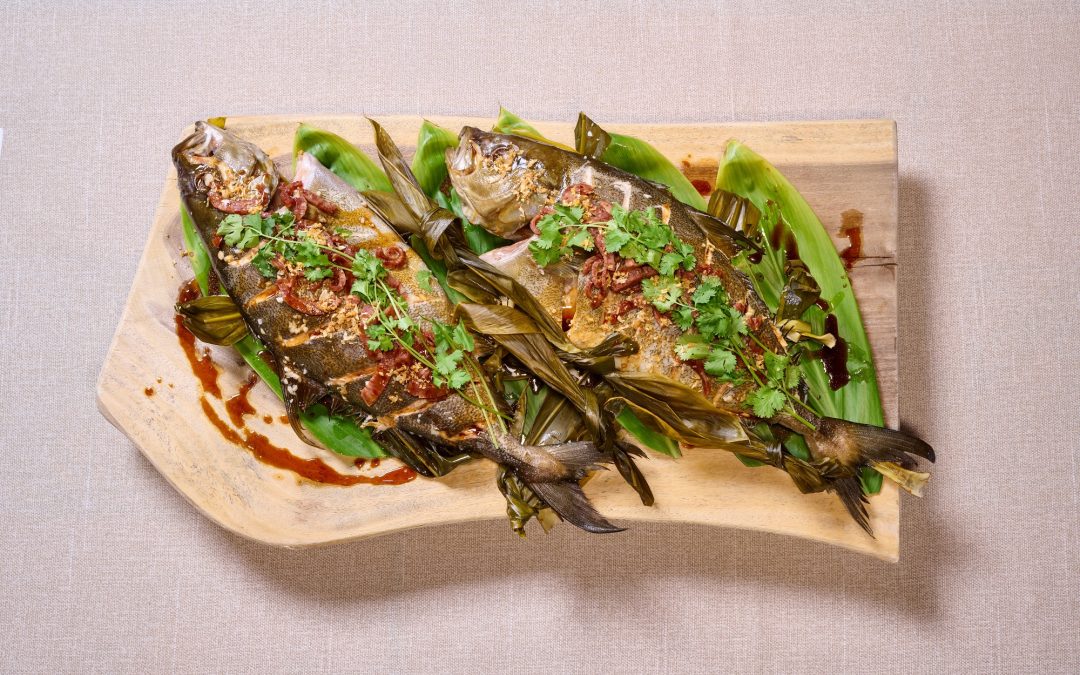“Hawaiian Kampachi/Kanpachi, also known as Almaco Jack (Seriola rivoliana), is prized by chefs for both sushi and cuisine due to its extremely high fat content and rich white flesh. The fish is marked by a dark blue-green upper body with a lavender-tinted belly and elongated fins.” Quote from todaysfarmedfish.org
Today’s recipe comes from our Hawaiian shores. Braxton Davis, former line chef with the Polynesian Cultural Center, gives us insight on how to prepare Kampachi perfectly.

A beautiful example of a fresh kampachi fish caught off of the shores of Hawaiʻi (photo courtesty of Hawaii Magazine)
What is Kampachi?
Kampachi is considered one of Hawaii’s delicacies. It contains a higher fat content than lots of other fish as well as a flesh that absorbs flavor far better than any other species of fish. Kampachi is popular in many Japanese, Malaysian, and Hawaiian dishes. Each dish is prepared a little differently depending on the region and culture.
How is Kampachi traditionally prepared?
The popular Grilled Kampachi that you will find at the Polynesian Culture Center and around the Islands of Hawaiʻi contain a mixture of ingredients from vegetables to various spices. The fish is wrapped in a banana leaf, which helps to keep it moist and to add flavor.
How does the Polynesian Cultural Center honor this tradition?
There’s no doubt that Hawaiian cuisine has its own differences and specialties and that’s what makes Kampachi such a diverse and interesting plate. Here at the Center, our seafood is fresh from the Pacific, the banana leaves are chopped straight from our onsite farm, and the dish is grilled traditionally to honor the culture found in Hawaiian cuisine. In this dish, the fish is cooked with all of the ingredients mixed in to achieve that rich flavor that the guests of the Center have come to love.

The Aliʻi Lūʻau Buffet includes fresh kampachi, roasted puaʻa (whole pig) and a variety of island inspired dishes.
Where can I try Kampachi?
Kampachi is found all throughout the islands of Hawaii as well as several Asian countries. You will discover that the grilled Kampachi found at the Center’s Aliʻi Lūʻau Buffet and Gateway Buffet is by far one of the best.
The attention to preserving the culture, flavor, and love that comes from Hawaii is what gives the Kampachi the best flavor on the island. Many restaurants will mass produce food for tourists to feel like they are eating authentic food. But the Center doesn’t tolerate that.
After spending several months perfecting the cuisine, I learned how important it is to prepare Kampachi with care and respect. When you try Kampachi, you are partaking in Hawaiian culture. We at the Polynesian Cultural Center consider it an honor and a duty to make sure that our preparation is consistent and exact.
How can I replicate this recipe at home?
If you’re interested in trying to make grilled Kampachi on your own, here is the recipe I’ve used to provide thousands of guests the best taste of seafood the islands has to offer.

The end result should look something like this!
RECIPE: Hawaiian Kampachi
Kampachi Recipe Ingredients:
NOTE: Measurements are approximate and should be based on the size of the fish. Make sure that the amounts are generous and the products fresh.
- ¼ cup ginger (chopped)
- ¼ cup garlic
- ¼ cup red onion
- 1 banana leaf for each fish (ti leaves can be used. If traditional leaves are not available, aluminum foil can be used)
- 1 tsp saimin soup base
- ½ tbsp fried shallots
- 10 kalamansi (limes or lemons can be substituted)
- 1 tbsp lime leaf (optional)
- 1 tbsp fish sauce

This is one way to wrap a smaller fish. Image courtesy of www.seriouseats.com

An example of how to wrap large fish. Image courtesy of maryamsculinarywonders.blogspot.com
Kampachi Recipe Instructions
PREPARATION
- Gut and clean the whole fish. NOTE: It is not traditionally trimmed, beheaded or scaled, which helps to maintain the flavor and consistency of this popular fish.
- Split the banana leaf and set it under the fish (this is used to wrap the fish).
- Cut the fish four ways down vertically and four ways horizontally.
- Stick the chopped ginger and garlic inside the cuts of the fish.
- Apply the saimin base and the fish sauce on top of the fish.
- Sprinkle the red onions on top of all of those ingredients and the fish.
- Wrap the banana leaf around the fish. Optional: secure with butchers twine.
- If your fish is large, layer banana leaves so that they have a decent amount of overlap until you have enough to fully wrap the fish.
COOKING TIPS
- At the Polynesian Cultural Center, the wrapped fish is quickly grilled on each side to lightly brown the leaves for presentation purposes.
- Place your fish on a baking sheet and cook in a 350o oven. Watch carefully. The important part is to not over cook it. The best way to accomplish this is by using a meat thermometer. You want the fish to reach between 145 – 160o (the Polynesian Cultural Center finds 145o preferable).
Unwrap and serve immediately.
BIOGRAPHY

Guest Blogger Braxton Davis grew up in Wyoming and Colorado. He is currently studying BUSM-Marketing and Minoring in French at Brigham Young University – Hawaii. Braxton worked for 6 months at the Polynesian Cultural Center’s Food Services Department. During that time he learned how to properly prepare Polynesian cuisine along with how much time and dedication goes into each dish. He loved being able to go beyond his comfort zone by making new and exciting dishes, from preparing the pig for the Ali’i Luau to the Kampachi Fish.


Recent Comments